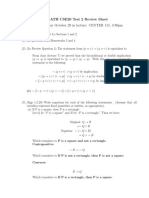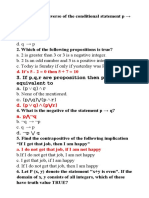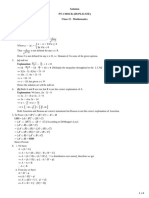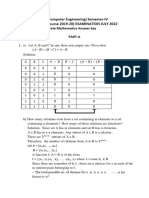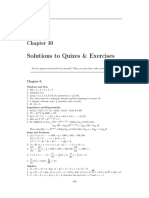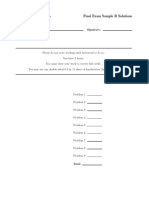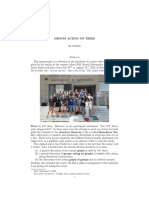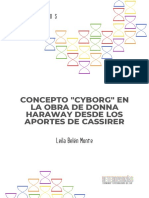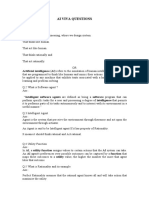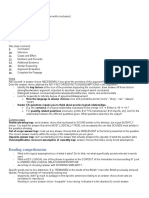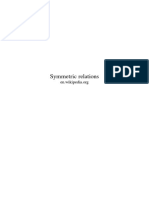Solution Manual for Discrete Mathematics 8th Edition
Uploaded by
2nomugnr0tSolution Manual for Discrete Mathematics 8th Edition
Uploaded by
2nomugnr0tSolution Manual + Answer Key
Solution Manual for Discrete Mathematics 8th Edition by Richard
Johnsonbaugh
View Full Product:
https://selldocx.com/products/solution-manual-discrete-mathematics-8e-johnsonb
Book Title: Discrete Mathematics
Edition: 8th Edition
Author: Richard Johnsonbaugh
Click above to view a sample
Solutions to Selected Exercises
Section 1.1
2. {2, 4} 3. {7, 10} 5. {2, 3, 5, 6, 8, 9} 6. {1, 3, 5, 7, 9, 10}
8. A 9. ∅ 11. B 12. {1, 4} 14. {1}
15. {2, 3, 4, 5, 6, 7, 8, 9, 10} 18. {n ∈ Z+ | n ≥ 6} 19. {2n − 1 | n ∈ Z+ }
21. {n ∈ Z+ | n ≤ 5 or n = 2m, m ≥ 3} 22. {2n | n ≥ 3} 24. {1, 3, 5}
25. {n ∈ Z+ | n ≤ 5 or n = 2m + 1, m ≥ 3} 27. {n ∈ Z+ | n ≥ 6 or n = 2 or n = 4}
29. 1 30. 3
33. We find that B = {2, 3}. Since A and B have the same elements, they are equal.
34. Let x ∈ A. Then x = 1, 2, 3. If x = 1, since 1 ∈ Z+ and 12 < 10, then x ∈ B. If x = 2, since 2 ∈ Z+ and
22 < 10, then x ∈ B. If x = 3, since 3 ∈ Z+ and 32 < 10, then x ∈ B. Thus if x ∈ A, then x ∈ B.
Now suppose that x ∈ B. Then x ∈ Z+ and x2 < 10. If x ≥ 4, then x2 > 10 and, for these values of x,
x∈/ B. Therefore x = 1, 2, 3. For each of these values, x2 < 10 and x is indeed in B. Also, for each of
the values x = 1, 2, 3, x ∈ A. Thus if x ∈ B, then x ∈ A. Therefore A = B.
37. Since (−1)3 − 2(−1)2 − (−1) + 2 = 0, −1 ∈ B. Since −1 ∈
/ A, A 6= B.
38. Since 32 − 1 > 3, 3 ∈
/ B. Since 3 ∈ A, A 6= B. 41. Equal 42. Not equal
45. Let x ∈ A. Then x = 1, 2. If x = 1,
x3 − 6x2 + 11x = 13 − 6 · 12 + 11 · 1 = 6.
Thus x ∈ B. If x = 2,
x3 − 6x2 + 11x = 23 − 6 · 22 + 11 · 2 = 6.
Again x ∈ B. Therefore A ⊆ B.
46. Let x ∈ A. Then x = (1, 1) or x = (1, 2). In either case, x ∈ B. Therefore A ⊆ B.
49. Since (−1)3 − 2(−1)2 − (−1) + 2 = 0, −1 ∈ A. However, −1 ∈
/ B. Therefore A is not a subset of B.
50. Consider 4, which is in A. If 4 ∈ B, then 4 ∈ A and 4 + m = 8 for some m ∈ C. However, the only value
of m for which 4 + m = 8 is m = 4 and 4 ∈ / C. Therefore 4 ∈
/ B. Since 4 ∈ A and 4 ∈
/ B, A is not a
subset of B.
Copyright c 2018 Pearson Education, Inc.
2 SOLUTIONS
53.
U
A B
54.
U
A B
56.
A B U
57.
U
A
B
C
59.
U
A B
62. 32 63. 105 65. 51
67. Suppose that n students are taking both a mathematics course and a computer science course. Then
4n students are taking a mathematics course, but not a computer science course, and 7n students are
taking a computer science course, but not a mathematics course. The following Venn diagram depicts
the situation:
Copyright c 2018 Pearson Education, Inc.
SOLUTIONS 3
Math
'$
'$
CompSci
4n n 7n
&%
&%
Thus, the total number of students is
4n + n + 7n = 12n.
The proportion taking a mathematics course is
5n 5
= ,
12n 12
which is greater than one-third.
69. {(a, 1), (a, 2), (b, 1), (b, 2), (c, 1), (c, 2)}
70. {(1, 1), (1, 2), (2, 1), (2, 2)} 73. {(1, a, a), (2, a, a)}
74. {(1, 1, 1), (1, 2, 1), (2, 1, 1), (2, 2, 1), (1, 1, 2), (1, 2, 2), (2, 1, 2), (2, 2, 2)}
77. Vertical lines (parallel) spaced one unit apart extending infinitely to the left and right.
79. Consider all points on a horizontal line one unit apart. Now copy these points by moving the horizontal
line n units straight up and straight down for all integers n > 0. The set of all points obtained in this
way is the set Z × Z.
80. Ordinary 3-space
82. Take the lines described in the instructions for this set of exercises and copy them by moving n units out
and back for all n > 0. The set of all points obtained in this way is the set R × Z × Z.
84. {1, 2}
{1}, {2}
85. {a, b, c}
{a, b}, {c}
{a, c}, {b}
{b, c}, {a}
{a}, {b}, {c}
88. False 89. True 91. False 92. True
94. ∅, {a}, {b}, {c}, {d}, {a, b}, {a, c}, {a, d}, {b, c}, {b, d}, {c, d}, {a, b, c}, {a, b, d},
{a, c, d}, {b, c, d}, {a, b, c, d}. All except {a, b, c, d} are proper subsets.
95. 210 = 1024; 210 − 1 = 1023 98. B ⊆ A 99. A = U
102. The symmetric difference of two sets consists of the elements in one or the other but not both.
103. A 4 A = ∅, A 4 A = U , U 4 A = A, ∅ 4 A = A
105. The set of primes
Copyright c 2018 Pearson Education, Inc.
4 SOLUTIONS
Section 1.2
2. Is a proposition. Negation: 6 + 9 6= 15.
3. Not a proposition
4. Is a proposition. Negation: π 6= 3.14.
6. Is a proposition. Negation: For every positive integer n, 19340 6= n · 17.
7. Is a proposition. Negation: Audrey Meadows was not the original “Alice” in the “Honeymooners.”
9. Is a proposition. Negation: The line “Play it again, Sam” does not occur in the movie Casablanca.
10. Is a proposition. Some even integer greater than 4 is not the sum of two primes.
12. Not a proposition. The statement is neither true nor false.
13. No heads were obtained. 15. No heads or no tails were obtained. 18. True
19. True 21. False 22. False
24.
p q (¬p ∨ ¬q) ∨ p
T T T
T F T
F T T
F F T
25.
p q (p ∨ q) ∧ ¬p
T T F
T F F
F T T
F F F
27.
p q (p ∧ q) ∨ (¬p ∨ q)
T T T
T F F
F T T
F F T
28.
p q r ¬(p ∧ q) ∨ (r ∧ ¬p)
T T T F
T T F F
T F T T
T F F T
F T T T
F T F T
F F T T
F F F T
Copyright c 2018 Pearson Education, Inc.
SOLUTIONS 5
30.
p q r ¬(p ∧ q) ∨ (¬q ∨ r)
T T T T
T T F F
T F T T
T F F T
F T T T
F T F T
F F T T
F F F T
32. ¬(p ∧ q). True. 33. p ∨ ¬(q ∧ r). True.
35. Lee takes computer science and mathematics.
36. Lee takes computer science or mathematics.
38. Lee takes computer science but not mathematics.
39. Lee takes neither computer science nor mathematics.
41. You do not miss the midterm exam and you pass the course.
42. You play football or you miss the midterm exam or you pass the course.
44. Either you play football and you miss the midterm exam or you do not miss the midterm exam and you
pass the course.
46. It is not Monday and either it is raining or it is hot.
47. It is not the case that today is Monday or it is raining, and it is hot.
50. Today is Monday and either it is raining or it is hot, and it is hot or either it is raining or today is
Monday.
51. p ∧ q 52. p ∧ ¬q 54. p ∨ q 55. (p ∨ q) ∧ ¬p 57. p ∧ r ∧ q
58. (p ∨ r) ∧ q 60. (q ∨ ¬p) ∧ ¬r 62. p ∧ ¬r 63. p ∧ q ∧ r
65. ¬p ∧ ¬q ∧ r 66. ¬(p ∨ q ∨ ¬r)
67.
p q p exor q
T T F
T F T
F T T
F F F
69. Inclusive-or 70. Inclusive-or 72. Exclusive-or 73. Exclusive-or
77. ”lung disease” -cancer
78. ”minor league” baseball team illinois -”midwest league”
Copyright c 2018 Pearson Education, Inc.
6 SOLUTIONS
Section 1.3
2. If Rosa has 160 quarter-hours of credits, then she may graduate.
3. If Fernando buys a computer, then he obtains $2000.
5. If a person gets that job, then that person knows someone who knows the boss.
6. If you go to the Super Bowl, then you can afford the ticket.
8. If a better car is built, then Buick will build it.
9. If the chairperson gives the lecture, then the audience will go to sleep.
11. If the switch is not turned properly, then the light will not be on.
13. Contrapositive of Exercise 2: If Rosa does not graduate, then she does not have 160 quarter-hours of
credits.
15. False 16. False 18. False 19. True 21. True 22. True
24. Unknown 25. Unknown 27. True 28. Unknown 30. Unknown
31. Unknown 34. True 35. True 37. True 38. False
40. True 41. False 44. (p ∧ r) → q 45. ¬((r ∧ ¬q) → r)
48. (¬p ∨ ¬r) → ¬q 49. r → q 51. q → (p ∨ r) 52. (q ∧ p) → ¬r
54. If it is not raining, then it is hot and today is Monday.
55. If today is not Monday, then either it is raining or it is hot.
57. If today is Monday and either it is raining or it is hot, then either it is hot, it is raining, or today is
Monday.
58. If today is Monday or (it is not Monday and it is not the case that (it is raining or it is hot)), then either
today is Monday or it is not the case that (it is hot or it is raining).
60. Let p: 4 > 6 and q: 9 > 12. Given statement: p → q; true. Converse: q → p; if 9 > 12, then 4 > 6; true.
Contrapositive: ¬q → ¬p; if 9 ≤ 12, then 4 ≤ 6; true.
61. Let p: |1| < 3 and q: −3 < 1 < 3. Given statement: q → p; true. Converse: p → q; if |1| < 3, then
−3 < 1 < 3; true. Contrapositive: ¬p → ¬q; if |1| ≥ 3, then either −3 ≥ 1 or 1 ≥ 3; true.
64. P 6≡ Q 65. P ≡ Q 67. P 6≡ Q 68. P ≡ Q 70. P 6≡ Q
71. P 6≡ Q 74. Either Dale is not smart or not funny.
75. Shirley will not take the bus and not catch a ride to school.
78. (a) If p and q are both false, (p imp2 q) ∧ (q imp2 p) is false, but p ↔ q is true.
(b) Making the suggested change does not alter the last line of the imp2 table.
79.
p q ¬(p ∧ q) ¬p ∨ ¬q
T T F F
T F T T
F T T T
F F T T
Copyright c 2018 Pearson Education, Inc.
SOLUTIONS 7
Section 1.4
2. Invalid
p→q
¬r → ¬q
... r
3. Valid
p↔r
r
... p
5. Valid
p → (q ∨ r)
¬q ∧ ¬r
... ¬p
7. Valid
(p ∨ q) → (r ∨ s)
p ∧ ¬r
... s
8. Invalid
p→r
q→s
¬(q ∧ p)
¬p
... s
11. If 4 megabytes of memory is better than no memory at all, then either we will buy a new computer or we
will buy more memory. If we will buy a new computer, then we will not buy more memory. Therefore if
4 megabytes of memory is better than no memory at all, then we will buy a new computer. Invalid.
12. If 4 megabytes of memory is better than no memory at all, then we will buy a new computer. If we will
buy a new computer, then we will buy more memory. Therefore, we will buy more memory. Invalid.
14. If 4 megabytes of memory is better than no memory at all, then we will buy a new computer. If we will
buy a new computer, then we will buy more memory. 4 megabytes of memory is better than no memory
at all. Therefore we will buy more memory. Valid.
16. If the hardware is unreliable or the output is correct, then the while loop is not faulty. If the output is
correct, then the while loop is faulty. Either the for loop is faulty or the output is correct. Therefore the
hardware is unreliable. Invalid.
17. If, if the for loop is faulty, then the hardware is unreliable, then the while loop is faulty. If, if the while
loop is faulty, then the output is correct, then the for loop is faulty. The hardware is unreliable and the
output is correct. Either the for loop is faulty or the while loop is faulty. Therefore the for loop is faulty
and the while loop is faulty. Invalid.
19. If the for loop is faulty, then the while loop is faulty or the hardware is unreliable. If the while loop is
faulty, then the for loop is faulty or the output is correct. Either the for loop is faulty or the while loop
is not faulty. The output is not correct. Therefore the for loop is faulty or the hardware is unreliable.
Invalid.
Copyright c 2018 Pearson Education, Inc.
8 SOLUTIONS
21. Valid 22. Valid 24. Valid
25. Suppose that p1 , p2 , . . . , pn are all true. Since the argument p1 , p2 / ... p is valid, p is true. Since
p, p3, . . . , pn are all true and the argument
p, p3 , . . . , pn / ... c
is valid, c is true. Therefore the argument
p1 , p2 , . . . , pn / ... c
is valid.
28. Modus ponens 29. Disjunctive syllogism
31. Let p denote the proposition “there is gas in the car,” let q denote the proposition “I go to the store,”
let r denote the proposition “I get a soda,” and let s denote the proposition “the car transmission is
defective.” Then the hypotheses are:
p → q, q → r, ¬r.
From p → q and q → r, we may use the hypothetical syllogism to conclude p → r. From p → r and
¬r, we may use modus tollens to conclude ¬p. From ¬p, we may use addition to conclude ¬p ∨ s. Since
¬p ∨ s represents the proposition “there is not gas in the car or the car transmission is defective,” we
conclude that the conclusion does follow from the hypotheses.
32. Let p denote the proposition “Jill can sing,” let q denote the proposition “Dweezle can play,” let r denote
the proposition “I’ll buy the compact disk,” and let s denote the proposition “I’ll buy the compact disk
player.” Then the hypotheses are:
(p ∨ q) → r, p, s.
From p, we may use addition to conclude p ∨ q. From p ∨ q and (p ∨ q) → r, we may use modus ponens
to conclude r. From r and s, we may use conjunction to conclude r ∧ s. Since r ∧ s represents the
proposition “I’ll buy the compact disk and the compact disk player,” we conclude that the conclusion
does follow from the hypotheses.
34. The truth table
p q p∨q
T T T
T F T
F T T
F F F
shows that whenever p is true, p ∨ q is also true. Therefore addition is a valid argument.
35. The truth table
p q p∧q
T T T
T F F
F T F
F F F
shows that whenever p ∧ q is true, p is also true. Therefore simplification is a valid argument.
Copyright c 2018 Pearson Education, Inc.
SOLUTIONS 9
37. The truth table
p q r p→q q→r p→r
T T T T T T
T T F T F F
T F T F T T
T F F F T F
F T T T T T
F T F T F T
F F T T T T
F F F T T T
shows that whenever p → q and q → r are true, p → r is also true. Therefore hypothetical syllogism is a
valid argument.
38. The truth table
p q p∨q ¬p
T T T F
T F T F
F T T T
F F F T
shows that whenever p ∨ q and ¬p are true, q is also true. Therefore disjunctive syllogism is a valid
argument.
Section 1.5
2. The statement is a command, not a propositional function.
3. The statement is a command, not a propositional function.
5. The statement is not a propositional function since it has no variables.
6. The statement is a propositional function. The domain of discourse is the set of real numbers.
8. 1 divides 77. True. 9. 3 divides 77. False. 11. For some n, n divides 77. True.
12. For every n, n does not divide 77. False.
14. It is false that for every n, n divides 77. True.
15. It is false that for some n, n divides 77. False.
17. False 18. True 20. True 21. True 23. False 24. True
26. ¬P (1) ∧ ¬P (2) ∧ ¬P (3) ∧ ¬P (4) 27. ¬(P (1) ∧ P (2) ∧ P (3) ∧ P (4))
29. ¬P (1) ∨ ¬P (2) ∨ ¬P (3) ∨ ¬P (4) 30. ¬(P (1) ∨ P (2) ∨ P (3) ∨ P (4))
33. Some student is taking a math course.
34. Every student is not taking a math course.
36. It is not the case that every student is taking a math course.
Copyright c 2018 Pearson Education, Inc.
10 SOLUTIONS
37. It is not the case that some student is taking a math course.
40. There is some person such that if the person is a professional athlete, then the person plays soccer. True.
41. Every soccer player is a professional athlete. False.
43. Every person is either a professional athlete or a soccer player. False.
44. Someone is either a professional athlete or a soccer player. True.
46. Someone is a professional athlete and a soccer player. True.
49. ∃x(P (x) ∧ Q(x))
50. ∀x(Q(x) → P (x))
54. True 55. True 57. False 58. True
60. No. The suggested replacement returns false if ¬P (d1) is true, and true if ¬P (d1) is false.
62. Literal meaning: Every old thing does not covet a twenty-something. Intended meaning: Some old thing
does not covet a twenty-something. Let P (x) denote the statement “x is an old thing” and Q(x) denote
the statement “x covets a twenty-something.” The intended statement is ∃x(P (x) ∧ ¬Q(x)).
63. Literal meaning: Every hospital did not report every month. (Domain of discourse: the 74 hospitals.)
Intended meaning (most likely): Some hospital did not report every month. Let P (x) denote the state-
ment “x is a hospital” and Q(x) denote the statement “x reports every month.” The intended statement
is ∃x(P (x) ∧ ¬Q(x)).
65. Literal meaning: Everyone does not have a degree. (Domain of discourse: People in Door County.)
Intended meaning: Someone does not have a degree. Let P (x) denote the statement “x has a degree.”
The intended statement is ∃x¬P (x).
66. Literal meaning: No lampshade can be cleaned. Intended meaning: Some lampshade cannot be cleaned.
Let P (x) denote the statement “x is a lampshade” and Q(x) denote the statement “x can be cleaned.”
The intended statement is ∃x(P (x) ∧ ¬Q(x)).
68. Literal meaning: No person can afford a home. Intended meaning: Some person cannot afford a home.
Let P (x) denote the statement “x is a person” and Q(x) denote the statement “x can afford a home.”
The intended statement is ∃x(P (x) ∧ ¬Q(x)).
69. The literal meaning is as Mr. Bush spoke. He probably meant: Someone in this country doesn’t agree
with the decisions I’ve made. Let P (x) denote the statement “x agrees with the decisions I’ve made.”
Symbolically, the clarified statement is ∃x ¬P (x).
71. Literal meaning: Every move does not work out. Intended meaning: Some move does not work out. Let
P (x) denote the statement “x is a move” and Q(x) denote the statement “x works out .” The intended
statement is ∃x(P (x) ∧ ¬Q(x)).
74. Let
p(x) : x is good.
q(x) : x is too long.
r(x) : x is short enough.
The domain of discourse is the set of movies. The assertions are
Copyright c 2018 Pearson Education, Inc.
SOLUTIONS 11
∀x(p(x) → ¬q(x))
∀x(¬p(x) → ¬r(x))
p(Love Actually)
q(Love Actually).
By universal instantiation,
p(Love Actually) → ¬q(Love Actually).
Since p(Love Actually) is true, then ¬q(Love Actually) is also true. But this contradicts, q(Love Actually).
77. Let P (x) denote the propositional function “x is a member of the Titans,” let Q(x) denote the propo-
sitional function “x can hit the ball a long way,” and let R(x) denote the propositional function “x can
make a lot of money.” The hypotheses are
P (Ken), Q(Ken), ∀x Q(x) → R(x).
By universal instantiation, we have Q(Ken) → R(Ken). From Q(Ken) and Q(Ken) → R(Ken), we may
use modus ponens to conclude R(Ken). From P (Ken) and R(Ken), we may use conjunction to conclude
P (Ken) ∧ R(Ken). By existential generalization, we have ∃x P (x) ∧ R(x) or, in words, someone is a
member of the Titans and can make a lot of money. We conclude that the conclusion does follow from
the hypotheses.
78. Let P (x) denote the propositional function “x is in the discrete mathematics class,” let Q(x) denote
the propositional function “x loves proofs,” and let R(x) denote the propositional function “x has taken
calculus.” The hypotheses are
∀x P (x) → Q(x), ∃x P (x) ∧ ¬R(x).
By existential instantiation, we have P (d) ∧ ¬R(d) for some d in the domain of discourse. From P (d) ∧
¬R(d), we may use simplification to conclude P (d) and ¬R(d). By universal instantiation, we have
P (d) → Q(d). From P (d) → Q(d) and P (d), we may use modus ponens to conclude Q(d). From Q(d)
and ¬R(d), we may use conjunction to conclude Q(d) ∧ ¬R(d). By existential generalization, we have
∃ Q(x) ∧ ¬R(x) or, in words, someone who loves proofs has never taken calculus. We conclude that the
conclusion does follow from the hypotheses.
80. By definition, the proposition ∃x ∈ D P (x) is true when P (x) is true for some x in the domain of
discourse. Taking x equal to a d ∈ D for which P (d) is true, we find that P (d) is true for some d ∈ D.
81. By definition, the proposition ∃x ∈ D P (x) is true when P (x) is true for some x in the domain of
discourse. Since P (d) is true for some d ∈ D, ∃x ∈ D P (x) is true.
Section 1.6
2. Everyone is taller than someone.
3. Someone is taller than everyone.
The solutions for 7–20 are for Exercise 2.
7. False 8. False 10. False 11. False 13. False 14. False
16. False 17. True 19. True 20. False
Copyright c 2018 Pearson Education, Inc.
12 SOLUTIONS
23. Everyone is taller than or the same height as someone.
24. Someone is taller than or the same height as everyone.
29. For every person, there is a person such that if the persons are distinct, the first is taller than the second.
30. There is a person such that, for every person, if the persons are distinct, the first is taller than the second.
35. ∀x∀yL(x, y). False. 36. ∃x∃yL(x, y). True. 40. ∀x ¬A(x, Profesor Sandwich)
41. ∀x∃yE(x) → A(x, y) 44. True 45. False 49. True 50. False
52. False 53. False 55. False 56. False 58. True 59. True
61. True 62. False 64. True 65. True
67. for i = 1 to n
if (forall dj (i))
return true
return false
forall dj (i) {
for j = 1 to n
if (¬P (di , dj ))
return false
return true
}
68. for i = 1 to n
for j = 1 to n
if (P (di , dj ))
return true
return false
70. Since the first two quantifiers are universal and the last quantifier is existential, Farley chooses x and y,
after which, you choose z. If Farley chooses values that make x ≥ y, say x = y = 0, whatever value you
choose for z,
(z > x) ∧ (z < y)
is false. Since Farley can always win the game, the quantified propositional function is false.
71. Since the first two quantifiers are universal and the last quantifier is existential, Farley chooses x and
y, after which, you choose z. Whatever values Farley chooses, you can choose z to be one less than the
minimum of x and y; thus making
(z < x) ∧ (z < y)
true. Since you can always win the game, the quantified propositional function is true.
73. Since the first two quantifiers are universal and the last quantifier is existential, Farley chooses x and y,
after which, you choose z. If Farley chooses values such that x ≥ y, the proposition
(x < y) → ((z > x) ∧ (z < y))
is true by default (i.e., it is true regardless of what value you choose for z). If Farley chooses values such
that x < y, you can choose z = (x + y)/2 and again the proposition
(x < y) → ((z > x) ∧ (z < y))
is true. Since you can always win the game, the quantified propositional function is true.
Copyright c 2018 Pearson Education, Inc.
SOLUTIONS 13
75. The proposition must be true. P (x, y) is true for all x and y; therefore, no matter which value for x we
choose, the proposition ∀yP (x, y) is true.
76. The proposition must be true. Since P (x, y) is true for all x and y, we may choose any values for x and
y to make P (x, y) true.
78. The proposition can be false. Let N denote the set of persons James James, Terry James, and Lee James;
let the domain of discourse be N × N ; and let P (x, y) be the statement “x’s first name is the same as
y’s last name.” Then ∃x∀yP (x, y) is true, but ∀x∃yP (x, y) is false.
79. The proposition must be true. Since ∃x∀yP (x, y) is true, there is some value for x for which ∀yP (x, y)
is true. Choosing any value for y whatsoever makes P (x, y) true. Therefore ∃x∃yP (x, y) is true.
81. The proposition can be false. Let P (x, y) be the statement x > y and let the domain of discourse be
Z+ × Z+ . Then ∃x∃yP (x, y) is true, but ∀x∃yP (x, y) is false.
82. The proposition can be false. Let P (x, y) be the statement x > y and let the domain of discourse be
Z+ × Z+ . Then ∃x∃yP (x, y) is true, but ∃x∀yP (x, y) is false.
84. The proposition can be true. Let P (x, y) be the statement x ≤ y and let the domain of discourse be
Z+ × Z+ . Then ∀x∀yP (x, y) is false, but ∃x∀yP (x, y) is true.
85. The proposition can be true. Let P (x, y) be the statement x ≤ y and let the domain of discourse be
Z+ × Z+ . Then ∀x∀yP (x, y) is false, but ∃x∃yP (x, y) is true.
87. The proposition can be true. Let N denote the set of persons James James, Terry James, and Lee James;
let the domain of discourse be N × N ; and let P (x, y) be the statement “x’s first name is different from
y’s last name.” Then ∀x∃yP (x, y) is false, but ∃x∀yP (x, y) is true.
88. The proposition can be true. Let P (x, y) be the statement x > y and let the domain of discourse be
Z+ × Z+ . Then ∀x∃yP (x, y) is false, but ∃x∃yP (x, y) is true.
90. The proposition can be true. Let P (x, y) be the statement x < y and let the domain of discourse be
Z+ × Z+ . Then ∃x∀yP (x, y) is false, but ∀x∃yP (x, y) is true.
91. The proposition can be true. Let P (x, y) be the statement x ≤ y and let the domain of discourse be
Z × Z. Then ∃x∀yP (x, y) is false, but ∃x∃yP (x, y) is true.
93. ∀x ∃y P (x, y) must be false. Since ∃x ∃y P (x, y) is false, for every x and for every y, P (x, y) is false.
Choose x = x0 in the domain of discourse. For this choice of x, P (x, y) is false for every y. Therefore
∀x ∃y P (x, y) is false.
94. ∃x ∀y P (x, y) must be false. Since ∃x ∃y P (x, y) is false, for every x and for every y, P (x, y) is false.
Choose y = y0 in the domain of discourse. Now, for any choice of x, P (x, y) is false for y = y0 . Therefore
∃x ∀y P (x, y) is false.
96. Not equivalent. Let P (x, y) be the statement x > y and let the domain of discourse be Z+ × Z+ . Then
¬(∀x∃yP (x, y)) is true, but ∀x¬(∃yP (x, y)) is false.
97. Equivalent by De Morgan’s law
100. ∃ε > 0 ∀δ > 0 ∃x ((0 < |x − a| < δ) ∧ (|f(x) − L| ≥ ε))
101. ∀L ∃ε > 0 ∀δ > 0 ∃x ((0 < |x − a| < δ) ∧ (|f(x) − L| ≥ ε))
102. Literal meaning: No school may be right for every child. Intended meaning: Some school may not be
right for some child. Let P (x, y) denote the statement “school x is right for child y.” The intended
statement is ∃x∃y¬P (x, y).
Copyright c 2018 Pearson Education, Inc.
14 SOLUTIONS
Problem-Solving Corner: Quantifiers
1. The statement of Example 1.6.6 is
∀x∃y(x + y = 0).
As was pointed out in Example 1.6.6, this statement is true. Now
∀x∀y(x + y = 0)
is false; a counterexample is x = y = 1. Also
∃x∀y(x + y = 0)
is false since, given any x, if y = 1 − x, then x + y 6= 0.
2. Yes; the statement ∀m∃n(m < n) with domain of discourse Z × Z of Example 1.6.1 also solves problems
(a) and (b).
Section 2.1
2. For all x, for all y, x + y = y + x.
3. An isosceles trapezoid is a trapezoid with equal legs.
5. The medians of any triangle intersect at a single point.
6. If 0 < x < 1 and ε > 0, there exists a positive integer n satisfying xn < ε.
8. Let m and n be odd integers. Then there exist k1 and k2 such that m = 2k1 + 1 and n = 2k2 + 1. Now
m + n = (2k1 + 1) + (2k2 + 1) = 2(k1 + k2 + 1).
Therefore, m + n is even.
9. Let m and n be even integers. Then there exist k1 and k2 such that m = 2k1 and n = 2k2 . Now
mn = (2k1 )(2k2 ) = 2(2k1 k2 ).
Therefore, mn is even.
11. Let m be an odd integer and n be an even integer. Then there exist k1 and k2 such that m = 2k1 + 1
and n = 2k2. Now
mn = (2k1 + 1)(2k2 ) = 2(2k1 k2 + k2 ).
Therefore, mn is even.
12. Let m and n be integers such that m and m + n are even. Then there exist k1 and k2 such that m = 2k1
and m + n = 2k2 . Now
n = (m + n) − m = 2k2 − 2k1 = 2(k2 − k1 ).
Therefore, n is even.
14. Let x and y be rational numbers. Then there exist integers m1 , n1 , m2 , n2 such that x = m1 /n1 and
y = m2 /n2 . Now xy = (m1 m2 )/(n1 n2 ). Therefore xy is rational.
15. Let x be a nonzero rational number. Then there exist integers m 6= 0 and n 6= 0 such that x = m/n.
Now 1/x = n/m. Therefore 1/x is rational.
Copyright c 2018 Pearson Education, Inc.
SOLUTIONS 15
17. Let m = 3k1 + 2 and n = 3k2 + 2 be integers of the prescribed from. Then
mn = 9k1 k2 + 6k1 + 6k2 + 4 = 3(3k1 k2 + 2k1 + 2k2 + 1) + 1
is of the form 3k3 + 1, where k3 = 3k1 k2 + 2k1 + 2k2 + 1.
19. x · 0 + 0 = x · 0 because b + 0 = b for all real numbers b
= x · (0 + 0) because b + 0 = b for all real numbers b
= x · 0 + x · 0 because a(b + c) = ab + ac for all real numbers a, b, c
Taking a = c = x · 0 and b = 0, the preceding equation becomes a + b = a + c; therefore, 0 = b = c = x · 0.
20. We must have X = Y . To prove this, suppose that x ∈ X. Since Y is nonempty, choose y ∈ Y . Then
(x, y) ∈ X × Y . Since X × Y = Y × X, (x, y) ∈ Y × X. Therefore x ∈ Y . Similarly, if x ∈ Y , then
x ∈ X. Thus X = Y .
22. Let x ∈ X. Then x ∈ X ∪ Y . Therefore X ⊆ X ∪ Y .
23. Let x ∈ X ∪ Z. Then x ∈ X or x ∈ Z. If x ∈ X, since X ⊆ Y , x ∈ Y . Therefore x ∈ Y ∪ Z. If x ∈ Z,
then x ∈ Y ∪ Z. In either case, x ∈ Y ∪ Z. Therefore X ∪ Z ⊆ Y ∪ Z.
25. Let x ∈ Z − Y . Then x ∈ Z and x ∈ / Y . Now x cannot be in X, for if x ∈ X, since X ⊆ Y , then x ∈ Y ,
which is not the case. Since x ∈ Z and x ∈/ X, x ∈ Z − X. Therefore Z − Y ⊆ Z − X.
26. Let x ∈ Y − (Y − X). Then x ∈ Y and x ∈ / Y − X. Since x ∈ Y , we must have x ∈ X (if x ∈
/ X, we
would have x ∈ Y − X). Therefore Y − (Y − X) ⊆ X.
Now let x ∈ X. Then x ∈ / Y − X. Since X ⊆ Y , x ∈ Y . Thus x ∈ Y − (Y − X). Therefore
X ⊆ Y − (Y − X). We have shown that Y − (Y − X) = X.
28. Let Z ∈ P(X) ∪ P(Y ). Then Z ∈ P(X) or Z ∈ P(Y ). If Z ∈ P(X), then Z is a subset of X and, thus,
Z is also a subset of X ∪ Y . Therefore Z ∈ P(X ∪ Y ). Similarly, if Z ∈ P(Y ), Z ∈ P(X ∪ Y ). In either
case, Z ∈ P(X ∪ Y ). Therefore P(X) ∪ P(Y ) ⊆ P(X ∪ Y ).
29. Let Z ∈ P(X ∩ Y ). Then Z is a subset of X ∩ Y . Therefore Z is a subset of X and a subset of Y . Thus
Z ∈ P(X) ∩ P(Y ). We have proved that P(X ∩ Y ) ⊆ P(X) ∩ P(Y ).
Let Z ∈ P(X) ∩ P(Y ). Then Z ∈ P(X) and Z ∈ P(Y ). Since Z ∈ P(X), Z is a subset of X. Since
Z ∈ P(Y ), Z is a subset of Y . Since Z is a subset of X and Y , Z is a subset of X ∩Y . Thus Z ∈ P(X ∩Y ).
Therefore P(X) ∩ P(Y ) ⊆ P(X ∩ Y ). It follows that P(X ∩ Y ) = P(X) ∩ P(Y ).
31. Let X = {a} and Y = {b}. Then
P(X) = {∅, {a}}, P(Y ) = {∅, {b}},
so
P(X) ∪ P(Y ) = {∅, {a}, {b}}.
Since X ∪ Y = {a, b},
P(X ∪ Y ) = {∅, {a}, {b}, {a, b}}.
Now {a, b} ∈ P(X ∪ Y ), but {a, b} ∈
/ P(X) ∪ P(Y ). Therefore P(X ∪ Y ) ⊆ P(X) ∪ P(Y ) is false in
general.









